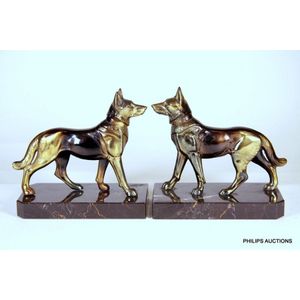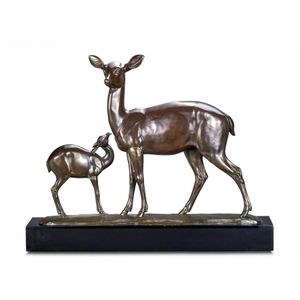1930s Spelter Stag on Marble Base
You must be a subscriber, and be logged in to view price and dealer details.
Subscribe Now to view actual auction price for this item
When you subscribe, you have the option of setting the currency in which to display prices to $Au, $US, $NZ or Stg.
- Onyx - Onyx is a form of agate, used from antiquity and popular again in the 1920s and 30s. European onyx is generally green, but can be many other colours, and can contain bands of black and/or white.
This multicoloured stone is widely used for table tops, lamp bases and in jewellery. Some types of onyx are also used for cameos of which the upper white layer is cut away to reveal the colour beneath. - Spelter - Spelter was the name given to an alloy of zinc and brass or copper used in the 19th century for statuary and lighting. It is a brittle bluish-white metal. It was used as a cheap replacement for bronze, but being brittle easily breaks and can't be repaired. When finished it can often be mistaken for bronze, but if discreet a scratch on the base displays shows a greyish colour, the metal is spelter, if a golden colour the metal is most likely bronze.
- Circa - A Latin term meaning 'about', often used in the antique trade to give an approximate date for the piece, usually considered to be five years on either side of the circa year. Thus, circa 1900 means the piece was made about 1900, probably between 1895 and 1905. The expression is sometimes abbreviated to c.1900.
This item has been included into following indexes:
Visually similar items

A pair of Art Deco spelter Alsatian bookends, circa 1920s, a pair of standing Alsatians in lustrous gold and chocolate bronze colours raised on veined black marble bases, height 14 cm, width 14 cm, depth 8 cm

After Nino de Fiesole, bronze figure, Cerf Bramant (Rutting stag), on white marble base, signed 'De. Fiesole, height 35 cm. Provenance: Private Collection, double Bay, NSW

A bronze figure group of a doe and fawn by Irenee Rochard, French, circa 1930 signed I. Rochard to the bronze base. 62 cm high, 76 cm wide, 17 cm deep

An Art Deco Lustred spelter Panther group on a marble and onyx base, circa 1930s, a pair of walking panthers, one growling, in chocolate and gold lustre colours upon a long rectangular base in yellow ochre and brown onyx colours trimmed with cream onyx and
